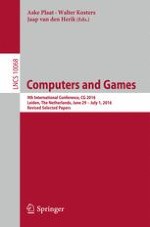This book constitutes the thoroughly refereed post-conference proceedings of the 9th International Conference on Computers and Games, CG 2016, held in Leiden, The Netherlands,in conjunction with the 19th Computer Olympiad and the 22nd World Computer-Chess Championship.
The 20 papers presented were carefully reviewed and selected of 30 submitted papers.
The 20 papers cover a wide range of computer games and many different research topics in four main classes which determined the order of publication: Monte Carlo Tree Search (MCTS) and its enhancements (seven papers), concrete games (seven papers), theoretical aspects and complexity (five papers) and cognition model (one paper). The paper Using Partial Tablebases in Breakthrough by Andrew Isaac and Richard Lorentz received the Best Paper Award.

 (black), and
(black), and
 (white) respectively, yields the following (illegal) position that counts all legal positions:
(white) respectively, yields the following (illegal) position that counts all legal positions: